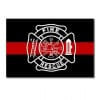Whats with a DI

tallman72
Posts: 353
so i notice that a lot of guitarist use a DI for there acoustics.
Why what do they do , do i need one when pluging into my acoustic amp,
Does anyone know?
Why what do they do , do i need one when pluging into my acoustic amp,
Does anyone know?
0
Comments
-
Usually used to make instrument level signals jive up with line level inputs, like XLRs. If that's wonky you can get buzz and weak signal.
0 -
I only use DIs when I'm NOT using an amp. I'll use it when I'm going directly into a soundboard. So, if I'm playing at church, instead of mic'ing the amp, I'll plug my guitar into the DI box and the box will go right into the soundboard so that it mixes easier with the vocals. The levels are set so that the amp isn't overpowering the front of the stage and the sound isn't too quiet in the back.Grand Rapids '04, Detroit '06
JEFF HARDY AND JEFF AMENT USED TO LOOK THE SAME
"Pearl Jam always eases my mind and fires me up at the same time.”-Jeff Hardy0 -
we use DIs when we play acoustically. if just plugs straight into the PA. it is really clean, as acoustics should be. you should not take an acoustic through the same amp you just played metallica through."You can tell the greatness of a man by what makes him angry." - Lincoln
"Well, you tell him that I don't talk to suckas."0 -
I mean, you can use an acoustic through that amp...but it probably won't sound too good. I used my stratacoustic through my roc pro 700. But I had to change the settings and turn the reverb just about OFF.gimmesometruth27 said:we use DIs when we play acoustically. if just plugs straight into the PA. it is really clean, as acoustics should be. you should not take an acoustic through the same amp you just played metallica through.
Grand Rapids '04, Detroit '06
JEFF HARDY AND JEFF AMENT USED TO LOOK THE SAME
"Pearl Jam always eases my mind and fires me up at the same time.”-Jeff Hardy0 -
If you have an acoustic amp, then it is designed for acoustic instruments to plug straight into it. In the musician's world, there are two basic signal types: instrument and microphone. Instrument signals are what comes out of guitars, basses, keyboards, etc, while microphone signal is what comes out of (you guessed it) microphones. To plug your acoustic guitar or keyboard directly into a mixer that is designed for microphone inputs, you need a Direct Input, or DI, converter. This does two basic things: it makes the signal balanced, a technical term that basically means the signal can travel for extreme lengths without degradation; and it adjusts signal voltage and impedance from instrument level to microphone level. This makes your guitar's signal look just like a microphone's signal at the mixer board.
Some mixers have 1/4" line inputs, and you can often plug an instrument directly into these inputs. However, you have two problems: line-level signals are different than instrument-level signals, although some keyboards and sequencers and electronica can be configured to output line-level signals; and the impedance of the instrument's output is much higher than a traditional line-level signal, which causes some fidelity problems in the mixer. Also, your signal will not be balanced, which means the signal will be limited to lengths of 20-30 feet before signal degradation takes over.
Even a cheap $30 DI box will balance the signal, lower the level, and match impedance, yielding a much cleaner signal to the mixer board. Most acoustic preamps include a DI output, and your acoustic amp may even have a DI output on the back panel. Most of the time, however, a sound guy will prefer to use a DI right out of your instrument or pedalboard, and then run a parallel output from the DI into your amp. This is generally true of bass guitars and keyboards as well.
Back to the primary question, an acoustic amplifier is designed for an instrument signal input, so you do not need a DI to plug an acoustic instrument into an acoustic amp. You could also plug your acoustic instrument into a regular electric guitar amp, but the results will likely be pretty disappointing. If you were to plug an acoustic instrument into a guitar tube amp, you would not be happy at all....and if you don't like it, you can suck on an egg.0
Categories
- All Categories
- 149K Pearl Jam's Music and Activism
- 110.2K The Porch
- 282 Vitalogy
- 35.1K Given To Fly (live)
- 3.5K Words and Music...Communication
- 39.3K Flea Market
- 39.3K Lost Dogs
- 58.7K Not Pearl Jam's Music
- 10.6K Musicians and Gearheads
- 29.1K Other Music
- 17.8K Poetry, Prose, Music & Art
- 1.1K The Art Wall
- 56.8K Non-Pearl Jam Discussion
- 22.2K A Moving Train
- 31.7K All Encompassing Trip
- 2.9K Technical Stuff and Help



